Assessing Outdoor Air Near Schools
Saint Josaphat School - Chicago, IL
Results and Analysis of EPA’s monitoring
EPA selected this school for monitoring because it is located near a steel production facility and a leather manufacturer that are sources of air toxics emissions. Computer models were used to determine which air toxics may be present at elevated levels in the outdoor air near the school. These models showed that hexavalent chromium, lead, and manganese could be present in the air around the school and prompted EPA to test to see if the levels present may be of concern.
| Primary Findings | Levels of hexavalent chromium, lead, and manganese in the air at the school are below levels of concern for short-term and long-term exposure. |
| Key Pollutants Monitored | Hexavalent chromium. Inhalation may damage the respiratory system and cause cancer if prople are exposed to high levels; Manganese. Inhalation may affect the nervous system if people are exposed to high levels; Lead. Inhalation and ingestion may affect the developing nervous system if people are exposed to high levels. |
| Next Steps | EPA will not extend air toxics monitoring at Saint Josaphat School at this time because levels of hexavalent chromium, lead, and manganese in the air at the school were below levels of concern for long-term exposure to air toxics. The Illinois Environmental Protection Agency (IEPA) will continue to oversee industrial facilities in the area through the facility’s Title V air permit and other programs. |
Summary of Study Approach and Findings
Approach:
- A monitor collected air samples from August 17 through October 22, 2009, at the Saint Josaphat School in Chicago, IL. Hexavalent chromium, lead, and manganese were the key pollutants of interest.
- We posted individual air sample results on this website throughout the monitoring period to keep your community informed during the monitoring period.
- During the monitoring period, we evaluated the monitored concentrations to see if there was a concern from short-term exposures (e.g., several weeks).
- When the monitoring was complete, we analyzed the results to see if there was a concern from long-term exposures (over a lifetime).
- Also, when the monitoring was complete, we evaluated all the air samples from the on-site monitor. We also evaluated information on wind speed and wind direction from a weather monitor at the school, along with historical weather information and information about the nearby sources of hexavalent chromium, lead, manganese emissions.
Findings:
- Based on the monitoring results, we found no concern for risk of health problems from short-term exposures to hexavalent chromium, lead, and manganese.
- Our analysis found that levels of hexavalent chromium, lead, and manganese in the air at the school are below levels of concern for long-term exposure.
- The analysis indicates that hexavalent chromium, lead, and manganese concentrations in the air near the school are influenced by nearby industrial facilities.
- The concentrations of hexavalent chromium, lead, and manganese measured at the school are lower than those suggested by the information that helped identify this school for monitoring.
- The process to identify schools for monitoring relied on emissions estimates and other information. Ambient air monitoring at the school allowed measurement of what was actually in the air.
- The most recently available chromium emissions estimates for the nearby facilities from EPA’s 2008 Toxics Release Inventory (TRI) are lower than the 2005 TRI and 2002 National-Scale Air Toxics Assessment (NATA) estimates originally used to identify this school for monitoring. The most recent lead emissions estimates from the 2008 TRI and 2005 NATA are lower at the leather manufacturer, but higher at the steel production facility (when compared to the 2005 TRI and 2002 NATA). Finally, the most recent manganese emissions estimates from the 2008 TRI at the steel production facility and the leather manufacturer arelower than the 2005 TRI estimates originally used to identify this school for monitoring. The leather manufacturer has revised their 2008 TRI data and also requested a revision downward from what was previously reported. IEPA is in agreement with the revisions.
- Because the analysis shows monitored concentrations of hexavalent chromium, lead, and manganese levels to be below levels of concern, EPA will not extend air toxics monitoring at Saint Josaphat School.
- Click here for additional information
How We Analyzed the Information We Collected at this School
The analysis considered whether the information collected at the school might raise concerns for the health of children or adults at the school. We looked at the following types of information:
- Measured hexavalent chromium, lead, and manganese concentrations and information on hexavalent chromium, lead, and manganese
- Measured wind direction and wind speed at the school
- Information about nearby sources of hexavalent chromium, lead, and manganese emissions
Analysis of Measured Hexavalent Chromium Concentrations:
1. Calculate the average: We calculated the average of the hexavalent chromium measurements (shown by the black diamond in the graph below). We compared this average to the long-term comparison level (thick line on the graph below).
Result: The average hexavalent chromium level for the samples collected was below the long-term comparison levels. The health concern is low.
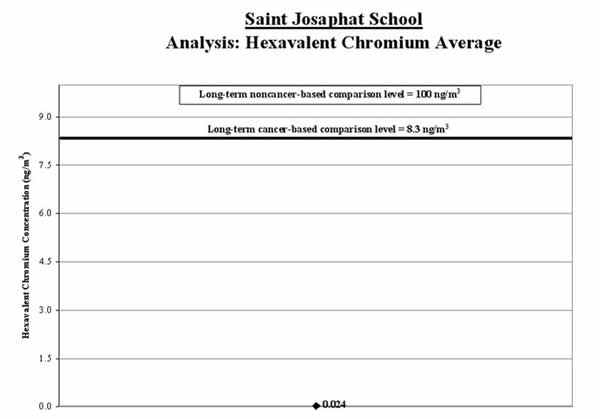
2. Calculate a range: To account for varying air concentrations of hexavalent chromium, we calculated a range around the average. We did this by estimating high and low values that the longer-term concentrations might reach using common statistical tools. We compared the highest point in the range (called the “upper bound”) to the long-term comparison levels.
Result: The high end of the range is lower than the comparison levels. The health concern is low.
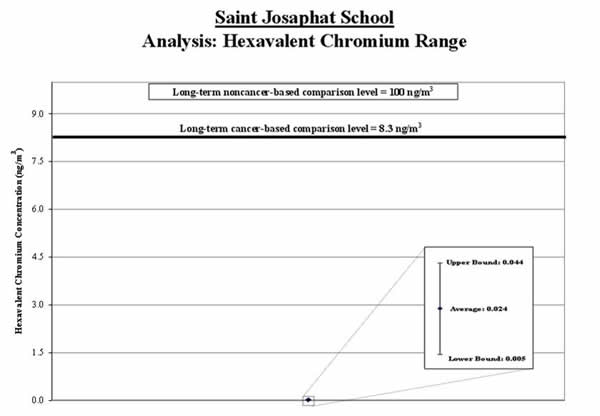
Analysis of Measured Lead Concentrations:
1. Calculate the average:We calculated the average of the lead measurements (shown by the black diamond in the graph below). We compared this average to the comparison level (thick line on the graph below). The comparison level is the level of the national ambient air quality standard (NAAQS) for lead.
Result: The average lead level for the samples collected was below the comparison level. The health concern is low.
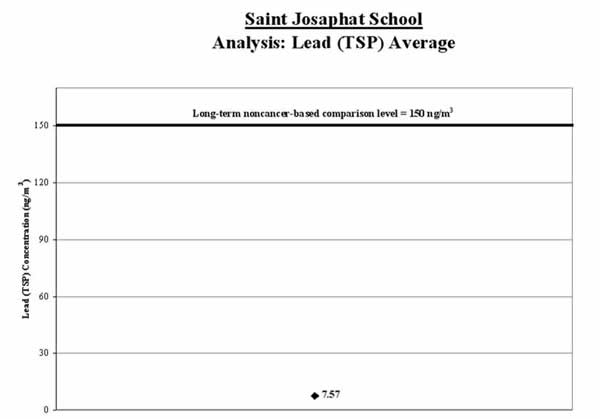
2. Calculate a range: To account for varying air concentrations of lead, we calculated a range around the average. We did this by estimating high and low values that the longer-term concentrations might reach using common statistical tools. We compared the highest point in the range (called the “upper bound”) to the comparison level.
Result: The high end of the range is lower than the comparison level. The health concern is low.
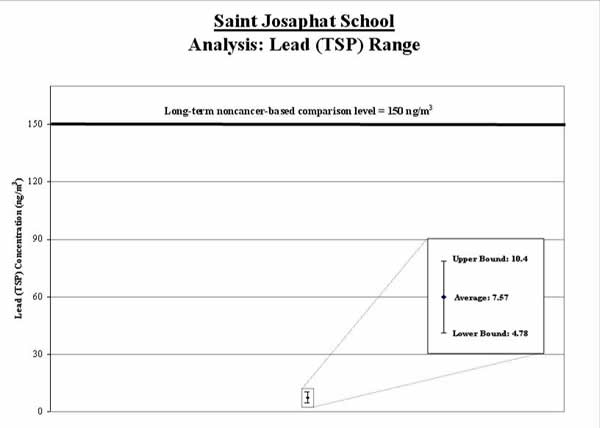
Analysis of Measured Manganese Concentrations:
1. Calculate the average: We calculated the average of the manganese measurements (shown by the black diamond in the graph below). We compared this average to the long-term comparison level (thick line on the graph below). The long-term comparison level represents the level of manganese in the air that is below levels associated with health concerns, even if someone breathed air containing manganese at that level all day, every day over a lifetime.
Result: The average manganese level for the samples collected was below the long-term comparison level. The health concern is low.

2. Calculate a range: To account for varying air concentrations of manganese, we calculated a range around the average. We did this by estimating high and low values that the longer-term concentrations might reach using common statistical tools. We compared the highest point in the range (called the “upper bound”) to the long-term comparison level.
Result: The high end of the range is lower than the comparison level. The health concern is low.
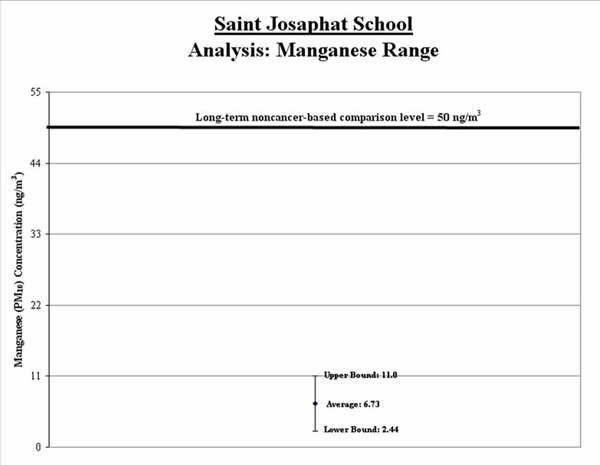
Analysis of Measured Wind Direction and Wind Speed at the School
We took measurements of wind direction and speed every day during the sample period. We took special note of the wind speed and direction on the days we took measurements of hexavalent chromium, lead, and manganese.
| What we looked at | What we found |
| We looked at whether the wind data taken on the days we took measurements of hexavalent chromium, lead, and manganese are similar or different from the wind patterns during the entire sampling period. | We found the wind patterns taken on the days we took measurements of hexavalent chromium, lead, and manganese to be generally similar to those observed during the entire sampling period. |
| We looked at whether the wind pattern during the sampling period is reflective of regional wind pattern over the long term. | Although we lack long-term wind data at the monitoring station, the wind patterns at the NWS site during the sampling period are somewhat similar to the historical long-term wind flow patterns at that location. This suggests that, on a regional scale, the 2‑month sampling period may be representative of year-round wind patterns. |
Analysis of Information on Nearby Sources ofHexavalent Chromium, Lead, andManganese Emissions
| What we looked at | What we found |
| Whether we could determine if the sources were operating as usual during the sampling period. | The leather manufacturing facility was operating at approximately 8% capacity during the sampling period and has been operating at that level for the past few years. |
| The steel production facility was operating at approximately 61% capacity during the sampling period. | |
| The concentrations of hexavalent chromium, lead, and manganese measured at the school are lower than those suggested by the information that helped identify this school for monitoring. | |
| The nearby sources of hexavalent chromium, manganese, and lead have Title V air permits issued by the State of Illinois that include operating requirements. |
Additional Information
Technical Report for School: Assessing Outdoor Air Near Schools: Saint Josaphat School (Chicago, IL) (PDF) (29pp, 199k). The technical report is geared toward risk assessors, risk managers, and other regulatory agencies.
Background on School Monitoring Effort
